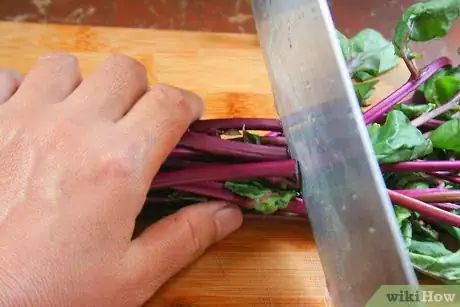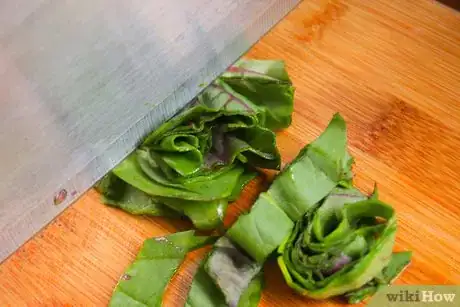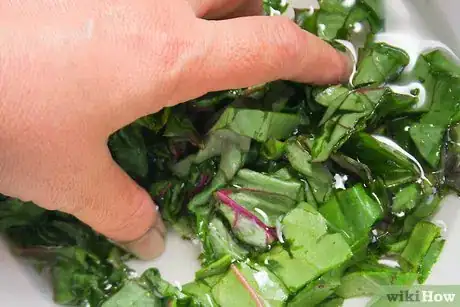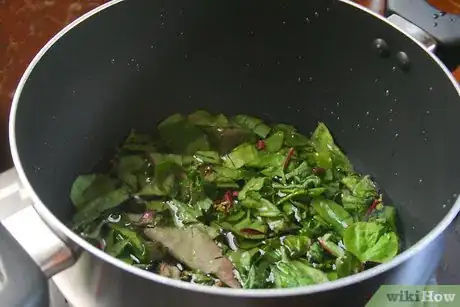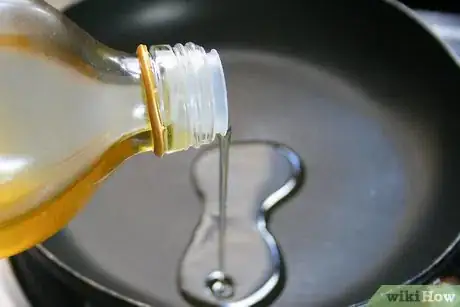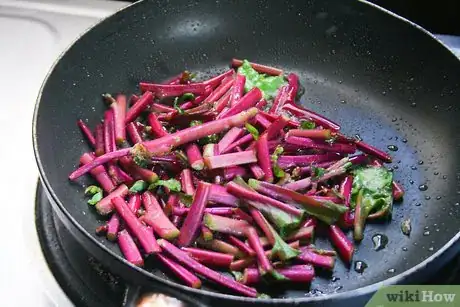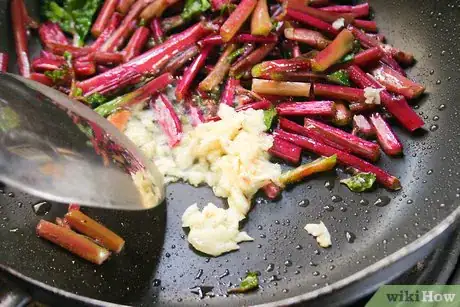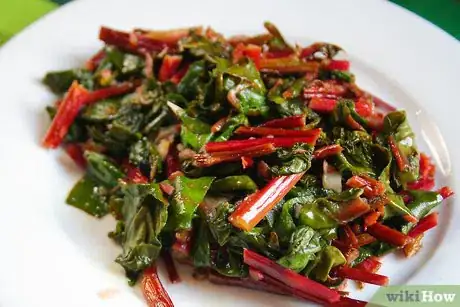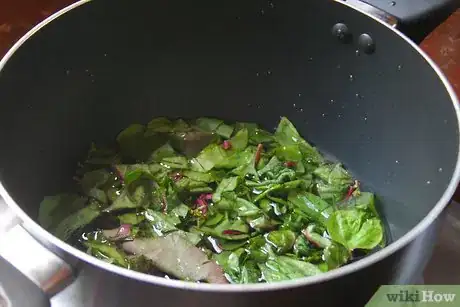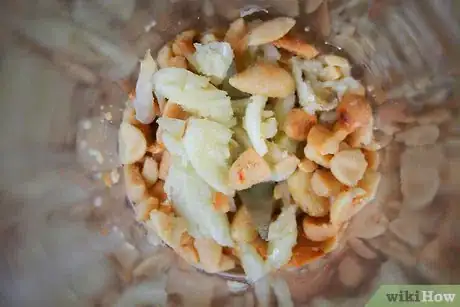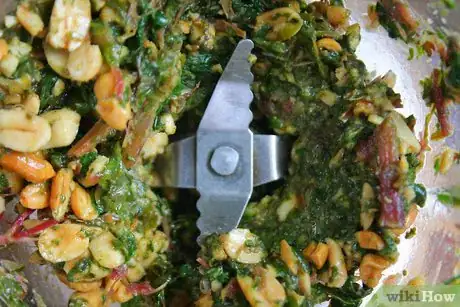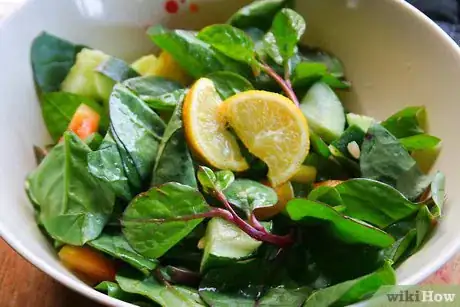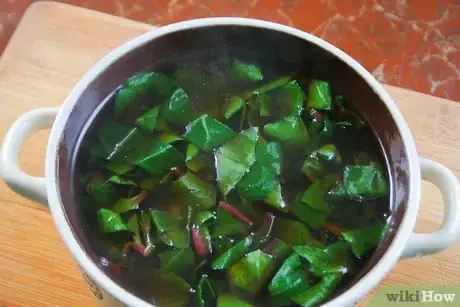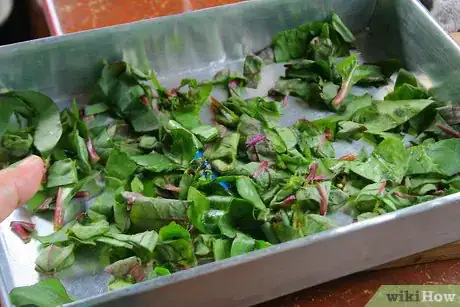This article was co-authored by Jerran Boyer. Chef Jerran Boyer is a Nutrition-Focused Professional Chef and the CEO of Health Nut Chefs. Chef Jerran has over 20 years of experience as a private chef. She and her team specialize in providing healthy, fresh-prepared meals designed with each client’s taste and dietary needs in mind. She and her team offer both personal, part-time chef services and private, full-time chef services in New York, New Jersey, and the Los Angeles area. Chef Jerran received her BS in Business Administration from the University of South Florida, a degree in Culinary Arts from Florida Culinary Institute, and a Plant-Based Nutrition Certificate through Cornell University.
There are 15 references cited in this article, which can be found at the bottom of the page.
This article has been viewed 103,284 times.
While most people know how to cook beets or beetroots, not many people know how to cook the greens of beets. These are a little saltier and stronger-flavored than most greens, but can easily be transformed into a tender and delicious side dish.
Ingredients
- 1–3 bunches beet greens
- 1–2 tbsp (30–45 mL) extra-virgin live oil
- 2 cloves garlic, diced
- 1 lemon, cut into wedges -- or 2 tablespoons (30 mL) vinegar
- 1 shallot or onion, diced (optional)
- ¼ tsp (1 mL) red pepper flakes (optional)
- 1 orange (optional)
- 1 bunch beet greens (roughly 4 ounces / 113 g)
- 4 cloves garlic, chopped
- ½ cup (120 mL) walnuts, pine nuts, or pistachios
- Up to ¾ cup (180 mL) extra-virgin olive oil
- Salt and pepper, to taste
- 1½ tbsp (22 mL) fennel fronds, 3 tbsp (45 mL) fresh parsley, and 1 tbsp (15 mL) lemon juice (optional)
Steps
Sautéed Beet Greens
-
1Trim off the stems (optional). The stems are edible, but not everyone likes their bitter taste. If you're not willing to try them, cut off the stems just below the leaves. You can remove the thick stem base from the largest leaves as well, cutting them out in a V pattern.[1]
- Like all greens, these will sauté down to a much smaller volume. You can cook a large mound at once, as long as it fits in your skillet. Put the lid on and simmer the greens to wilt them down.
-
2Roll up the leaves and chop them. Bunch the leaves together and roll them into a cylinder. Chop them into bite-size pieces, at roughly ½–1 inch (1.25–2.5 cm) intervals.[2]
- If using the stems, chop them into chunks of similar size.
Advertisement -
3Wash the greens. You can use a salad spinner, or submerge the greens in a bowl of water and rub off any noticeable dirt. Leave it for a couple seconds to let grit sink to the bottom. Lift out the leaves and repeat if necessary until the water comes out clear. Move the leaves to a separate bowl, leaving them damp.
- If using the stems, wash them in a separate bowl.
-
4Blanch the greens (optional). This will preserve the bright, green color, but the beet greens will cook fine without it. Here's how to go about it:
- Prepare an ice bath: a bowl of cold water and ice.
- Submerge the greens in boiling water for one minute.
- Remove the hot greens with tongs or drain them into a strainer or colander. Place them in the ice bath until cold.
- Drain into a strainer.
-
5Heat olive oil in a skillet. Add enough extra-virgin olive oil to coat the base of your skillet or frying pan, about 1–2 tablespoons (15–30 mL). Heat over medium heat until the oil shimmers, or a drop of water sizzles when flicked onto the oil.
-
6Cook stems for 4 minutes (optional). If using the chopped beet stems, add them to the pan first. Sauté for 4 minutes, or until slightly softened.
-
7Add and cook garlic for 1 minute. Dice two cloves of garlic; add them to the pan. Cook for about one minute, or until the garlic turns translucent.
- Optionally, add a diced shallot and/or ¼ tsp (1 mL) red pepper flakes.
-
8Cook the leaves and cover until wilted. Add the chopped leaves to the pan without stirring. Cover and let wilt to a much smaller mound, about 1–3 minutes.
- The water from the rinsing should be enough to steam the leaves slightly. If the leaves don't start shrinking within 30–60 seconds, or if the garlic starts turning brown, add a couple more spoonfuls of water.
-
9Serve or cook with acidic flavors. Vinegar or lemon juice cuts the bitter flavor of the beet greens. Provide lemon wedges to squeeze over the greens, or remove from heat and splash them with your favorite type of vinegar.
- For a more intense acidic flavor, add 1–2 tablespoons (15–30 mL) vinegar to the pan along with the juice of one orange. Simmer for an additional 2–3 minutes or until liquid has boiled away. Serve topped with orange zest.[3]
- Beet greens are high in sodium already, but you may add a pinch of salt and pepper if you think the dish needs more flavor.[4]
Beet Green Pesto
-
1Trim and rinse the greens. Start with one bunch of greens, roughly 4 ounces (113 g). Cut off thick stems, or leave a few short pieces if you want bright red streaks in the pesto.[5] Rinse off dirt.
-
2Blanch the beet greens. This will make the greens and stems a bit less tough. Get your kitchen tongs ready and blanch as follows:
- Prepare a bowl of cold water and ice.
- Bring a large pot of water to a boil, then drop the leaves in for 1 minute.
- Transfer the greens to the ice bath until cool, then remove.
-
3Toast the nuts. Pine nuts or walnuts are the most common options, but you can try pistachio for a more unusual flavor. Shell them, then toast in a dry, hot pan over medium heat, stirring frequently; they burn easily. The nuts are ready when golden brown and aromatic.[8] If the nuts have skins, rub them after toasting with a clean cloth to remove them.
- Pine nuts take about 5 minutes.
- Walnuts take 10–15 minutes.
- Pistachios take 6–8 minutes.[9]
-
4Pulse garlic and nuts in a food processor. Add chopped garlic and toasted nuts to a food processor with a metal blade. Pulse (on and off) until coarsely ground.
-
5Blend with other ingredients. Tear the leaves into pieces and add them to the processor. Add Parmesan and pulse until coarsely ground. Continue blending as you pour in a thin stream of olive oil, until you get the thick, homogenous texture of pesto.[10] Taste, then blend in salt and pepper as desired.
- You may need more or less olive oil than the recipe calls for.
- Optionally, complement the pistachio version with 1½ tbsp (22 mL) fennel fronds, 3 tbsp (45 mL) fresh parsley, and 1 tbsp (15 mL) lemon juice.[11]
-
6Serve. Dip crusty bread into this bold pesto, or add a dollop to a creamy soup. Thinned with water, you can use it as a pasta sauce. [12] On homemade pizza, use it instead of tomato sauce and top with slices of roasted beets or other pizza toppings.[13]
- Store leftovers in the fridge for up to one week. For longer storage, pour into ice cube trays, cover with olive oil to prevent darkening, and freeze. Pop out into plastic freezer bags and store up to 6 months.[14]
Additional Recipes
-
1Serve raw beet greens in salad. Raw beet greens have a strong flavor, so they're best paired with other powerful ingredients. Mix with feta, Romano cheese, goat cheese, or anchovies. Make Tahini, strawberry vinaigrette, or another strong or acidic dressing to complement this salad well.
- Beet greens become more bitter and toughen as they age. When serving raw, it's best to stick with the young greens sold in late spring or early summer.[15]
-
2Add sautéed greens to soup. Sauté with other aromatic ingredients, then mix it into the soup for the last couple minutes of simmering. This works well in thick soups made from lentils, beans or a cream base.
-
3Bake leaves into crisp chips. These chips are a little thicker and taste a bit "plantier" than other leaf, green vegetables. But if you've converted to the beet green fans and want them on the go, this is a great recipe:[16]
- Preheat oven to 350ºF (175ºC).
- Cut off stems, wash and pat dry the leaves in a kitchen towel.
- Toss leaves with a light coating of olive oil. Add salt and pepper if desired (taste first; beet greens are already salty).
- Bake on parchment paper-lined pans for 15 minutes, turn, and bake for 10 more minutes.
Expert Q&A
-
QuestionWhat is the best way to eat beet greens?
 Jerran BoyerChef Jerran Boyer is a Nutrition-Focused Professional Chef and the CEO of Health Nut Chefs. Chef Jerran has over 20 years of experience as a private chef. She and her team specialize in providing healthy, fresh-prepared meals designed with each client’s taste and dietary needs in mind. She and her team offer both personal, part-time chef services and private, full-time chef services in New York, New Jersey, and the Los Angeles area. Chef Jerran received her BS in Business Administration from the University of South Florida, a degree in Culinary Arts from Florida Culinary Institute, and a Plant-Based Nutrition Certificate through Cornell University.
Jerran BoyerChef Jerran Boyer is a Nutrition-Focused Professional Chef and the CEO of Health Nut Chefs. Chef Jerran has over 20 years of experience as a private chef. She and her team specialize in providing healthy, fresh-prepared meals designed with each client’s taste and dietary needs in mind. She and her team offer both personal, part-time chef services and private, full-time chef services in New York, New Jersey, and the Los Angeles area. Chef Jerran received her BS in Business Administration from the University of South Florida, a degree in Culinary Arts from Florida Culinary Institute, and a Plant-Based Nutrition Certificate through Cornell University.
Nutrition-Focused Professional Chef Well, you can use them in a variety of ways, such as sautéed, in a pesto or as a salad, like in the instructions above. You can also add the greens at the end of a soup (such as a vegetable soup, bean soup, or even chicken noodle for extra nutrients).
Well, you can use them in a variety of ways, such as sautéed, in a pesto or as a salad, like in the instructions above. You can also add the greens at the end of a soup (such as a vegetable soup, bean soup, or even chicken noodle for extra nutrients). -
QuestionCan beet leaves be boiled?
 MnmixCommunity AnswerYes, beet leaves can be boiled and eaten along with the rest of the beet. Make sure it is clean before boiling.
MnmixCommunity AnswerYes, beet leaves can be boiled and eaten along with the rest of the beet. Make sure it is clean before boiling.
Warnings
- Eating beet stems or beetroot causes red urine in roughly 12% of people. This is harmless, but seems to happen more often to people with iron deficiency. Consider eating more iron-rich foods and increasing your iron absorption.⧼thumbs_response⧽
- Avoid eating beets if you've had a calcium oxalate kidney stone, or if your doctor say you are at risk for one.[18]⧼thumbs_response⧽
- Beet juice will stain cutting boards, clothes, and just about everything else. You can remove the stain using bleach, detergent, or – if you're quick – a piece of wet bread.[19] [20]⧼thumbs_response⧽
Things You'll Need
- Sharp knife
- Skillet or frying pan
- Lid for pan
- Saucepan
- Large bowl
- Ice
- Wooden spoon
- Food processor
Expert Interview
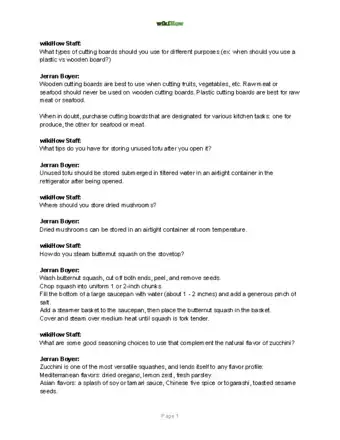
Thanks for reading our article! If you'd like to learn more about cooking vegetables, check out our in-depth interview with Jerran Boyer.
References
- ↑ https://www.youtube.com/watch?v=TP8qrYiPoVM
- ↑ https://www.youtube.com/watch?v=TP8qrYiPoVM
- ↑ http://www.spoonforkbacon.com/2013/06/citrus-sauteed-beet-stems/
- ↑ http://www.healthy-beets.com/beet-greens-recipe.html
- ↑ http://www.seriouseats.com/recipes/2013/07/beet-and-radish-green-pesto-pasta-recipe.html
- ↑ http://www.plantoeat.com/blog/2014/08/beet-greens-pesto-course/
- ↑ http://www.seriouseats.com/recipes/2013/07/beet-and-radish-green-pesto-pasta-recipe.html
- ↑ http://www.mybakingaddiction.com/how-to-toast-nuts-tutorial/
- ↑ http://www.cravingsofalunatic.com/2014/08/how-to-toast-pistachios.html
- ↑ http://ohmyveggies.com/beet-green-pesto-pizza-with-roasted-beets-goat-cheese/
- ↑ http://www.lecreuset.com/beet-soup-with-beet-green-pesto
- ↑ http://www.seriouseats.com/recipes/2013/07/beet-and-radish-green-pesto-pasta-recipe.html
- ↑ http://ohmyveggies.com/beet-green-pesto-pizza-with-roasted-beets-goat-cheese/
- ↑ http://www.theyummylife.com/How_to_make_Pesto
- ↑ http://www.healthyseasonalrecipes.com/what-to-do-with-beet-greens-and-a-recipe-for-beet-green-salad-with-sherry-vinaigrette-and-feta/
- ↑ http://whiteonricecouple.com/recipes/baked-beet-greens/
- ↑ http://www.healthyseasonalrecipes.com/what-to-do-with-beet-greens-and-a-recipe-for-beet-green-salad-with-sherry-vinaigrette-and-feta/
- ↑ http://my.clevelandclinic.org/services/urology-kidney/treatments-procedures/kidney-stones-oxalate-controlled-diet
- ↑ http://www.kidspot.co.nz/PersilFunZone/article+3584+233+How-to-remove-beetroot-stains.htm
- ↑ http://www.stain-removal-101.com/beet-juice-stains.html
About This Article
To sauté beet greens, start by trimming off the stems, unless you don’t mind the bitter taste. Then, roll up the leaves and chop them into bite-sized pieces. Give the leaves a quick soak to remove grime, then blanch them by boiling them for 1 minute and then putting them in an ice bath until they’re cold. When you’re ready to start cooking, heat a little olive oil in a skillet until it shimmers, then add some garlic and cook it for a minute to add flavor. Finally, stir in the leaves, cover them, and let them wilt for 1-3 minutes before serving. For more cooking tips, including how to make a scrumptious beet green pesto, keep reading!
